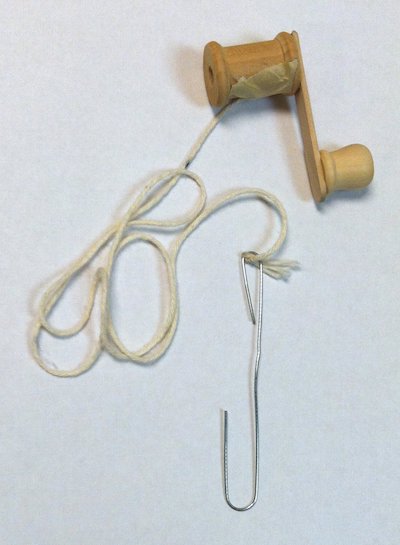A Toy Crank
A “simple machine” made from a spool and a popsicle stick.
When discussing mechanics and “simple machines” with younger children, I like to have them make their own devices whenever possible. Here's a simple project, but one that kids seem to love — a toy crank, complete with a “winch” for lifting something. You can buy spools of various sizes, popsicle sticks, and craft knobs at craft stores, and then glue them together as shown with Elmer's glue or wood glue. Depending on the size of your pieces, you might want to use a whole popsicle stick, or break one in half as I did. For a cargo hook, you can bend open a paperclip, tie it to the end of a string, and then tape or glue the other end to the crank spool.

When I first came up with this idea, I was worried that without a solid mount, kids wouldn't be able to have much fun with it, but I was surprised. I just had my kids slip the spool over a pencil, and hold this “axle” in one hand while they cranked with the other, and they really seemed to enjoy just lifting things on the cargo hook this way. (I tried this with children younger than maybe 10 or 12. I assume older kids would find making their own toy to be a bit “childish,” although it still might be useful to have a large classroom demonstration model just to help illustrate the principles behind the crank and the winch.)
What Exactly is a "Crank"?
With pry-sticks and pliers and other simple “levers,” you grab the long end and make the short end do the work, and it gives you more power. Leverage works like a “muscle magnifier,” letting you move heavier loads with less strength. (I didn't normally have my kids make their own “toy levers,” because you can find examples everywhere — can openers, nutcrackers, crowbars, the brake handles and brake calipers of a bicycle, and on and on. Everywhere you use your muscle power to get things done, there are probably levers to help you. Even a simple stick can be a lever if you use it to pry things.)
But levers have a problem. You move them once, and then you have to stop and re-adjust things. Levers are single-action devices. But in many cases, we'd like to have the power of the lever, but be able to use it in a continuous, ongoing way. We'd like to use leverage to lift something very high, or move something very far. This is the purpose of a “crank.” A crank is like a lever that can go around and around in circles, forever. It is like a cross between a lever and a wheel. The pedals on your bicycle are technically another example of a “crank.” So is the handle on a manual pencil sharpener. You can probably think of many more examples if you pay attention to the handles and pedals on the tools in the world around you.
Winding up the string on the spool also illustrates the principle of a “winch,” which is another helpful device for getting work done. If you keep your eyes open, you can probably start seeing examples of winches everywhere, as well.
By the way, I like to include cranks in our discussion of “simple machines”, because it is not one of the “classical six.” When we make a list of “simple machines,” why do some machine parts count, and other machine parts don't? Why do we put “levers” and “pulleys” on the list, but not cranks, or springs, or rollers? And doesn't it seem silly to say “wheel and axle” instead of just “wheel”? Or is there really an important difference?